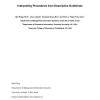95
Voted
JBI
2006
15 years 29 days ago
2006
Online medical information, when presented to clinicians, must be well-organized and intuitive to use, so that the clinicians can conduct their daily work efficiently and without ...
115
Voted
JBI
2006
15 years 29 days ago
2006
To microarray expression data analysis, it is well accepted that biological knowledge-guided clustering techniques show more advantages than pure mathematical techniques. In this ...
113
click to vote
JBI
2006
15 years 29 days ago
2006
Bridging levels of ``granularity'' and ``scale'' are frequently cited as key problems for biomedical informatics. However, detailed accounts of what is meant b...
100
Voted
JBI
2006
15 years 29 days ago
2006
Bioinformatics is a dynamic research area in which a large number of algorithms and programs have been developed rapidly and independently without much consideration so far of the...
JBI
2006
15 years 29 days ago
2006
JBI
2006
15 years 29 days ago
2006
Concerns about the deleterious effects of missing data may often determine which characters and taxa are included in phylogenetic analyses. For example, researchers may exclude ta...
81
Voted
JBI
2006
15 years 29 days ago
2006
Throughout history, philosophers, scientists, and other scholars have named and organized the salient elements of the world. These efforts have led to conceptualizations that diff...
114
click to vote
JBI
2006
15 years 29 days ago
2006
Numerous metrics have been developed that attempt to assess the reliability of phylogenetic trees. Several of these commonly used measures of tree and tree branch support are desc...
JBI
2006
15 years 29 days ago
2006
Systematic analyses are included as integral parts of bioinformatic analysis. The use of phenetic and phylogenetic trees in many of the newer areas of biology create a need for bi...
JBI
2006
15 years 29 days ago
2006
A 1998 paper that delineated desirable characteristics, or desiderata for controlled medical terminologies attempted to summarize emerging consensus regarding structural issues of...





